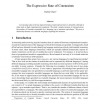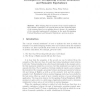TC
2008
15 years 8 days ago
2008
Synchronous systems offer clean semantics and an easy verification path at the expense of often inefficient implementations. Capturing design specifications as synchronous models a...
106
Voted
CONCUR
2006
Springer
15 years 4 months ago
2006
Springer
Impossible futures equivalence is the semantic equivalence on labelled transition systems that identifies systems iff they have the same "AGEF" properties: temporal logic...
96
Voted
NLPRS
2001
Springer
15 years 4 months ago
2001
Springer
It is important for future NLP systems to formulate the semantic equivalence (and more generally, the semantic similarity) of natural language expressions. In particular, paraphra...
AMAI
2004
Springer
15 years 5 months ago
2004
Springer
In reasoning tasks involving logical formulas, high expressiveness is desirable, although it often leads to high computational complexity. We study a simple measure of expressiven...
100
Voted
CAEPIA
2005
Springer
15 years 6 months ago
2005
Springer
After defining what is understood by textual entailment and semantic equivalence, the present state and the desirable future of the systems aimed at recognizing them is shown. A c...
105
Voted
OTM
2009
Springer
15 years 7 months ago
2009
Springer
Complex event processing (CEP) is a software architecture paradigm that aims at low latency, high throughput, and quick adaptability of applications for supporting and improving ev...



